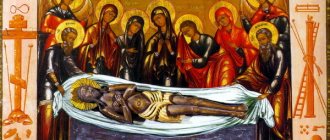2018.11.22
In this article we will talk about the Orthodox church canons, according to which it is customary to care for graves after a funeral. Let us answer the following questions that often interest relatives of the deceased.
- When are the wreaths removed from the grave?
- Is a cross necessary?
- Where should I place it?
- When can a monument be erected after a funeral?
- Is it possible not to remove the cross?
Moreover, this is only a part of the issues that we will touch upon. So, let's begin.
Which flowers are better, fresh or artificial?
The Church recommends decorating the graves of the deceased with living plants. Let's talk about the colors that are best suited for this.
- Periwinkle. This low-growing plant creeping along the soil is most often planted on the graves of the deceased. As this flower grows, it replaces the weed. Graves with planted periwinkles look beautiful and well-groomed.
- Irises. These flowers are also mourning flowers. Northern varieties of irises are usually planted on graves. Their advantage is their ease of maintenance.
- Crocuses. These low perennial flowers bloom in late summer and fall. Ideal for planting in flower beds that receive full sun most of the day.
If unpretentiousness is important to you, sow perennial dwarf plants on the grave. The most popular include rudbeckia, calendula and echinacea. The best trees are juniper and thuja. They have small root systems.
Is it possible to replace a cross on a grave if it has rotted, broken or fallen?
Wooden crosses cannot boast of such strength and durability as granite and marble tombstones. In this regard, under the influence of rain, strong wind, snow and other natural phenomena, the cross may become askew, break or even fall. In this case, the clergy recommend correcting the ritual item - it must be securely fixed in the soil and located perpendicular to the ground level. If the cross is broken, you can install a new one or order a tombstone stele made of granite or marble. The same should be done if the product is rotten - it needs to be replaced with a new one, or a monument should be erected.
How to care for a grave
You can restore order at the site according to church canons after the 40th day whenever it is convenient, except for the days that we will discuss below. Routine cleaning includes:
- alignment or replacement of artificial flowers placed on the grave;
- care of living plants;
- cleaning the area;
- cleaning the monument, flower garden and other ritual accessories.
The church says the more often you clean, the better. These events are considered a gesture of love for the departed.
Conclusion
Each family must independently decide what to do with the cross after the installation of the monument.
All the options described in the article are approved by the church, but if you have another decision or doubts, you can contact a clergyman and, after consulting, make a final decision. In any case, one should act in accordance with religious traditions. If at the time of installation of the monument the cross has not yet become unusable, it is better to simply leave this ritual item on the grave, because this does not contradict church canons and does not require any action from the relatives of the deceased. This method is optimal: it will be possible to preserve the cross at the burial site and erect a tombstone.
When is it forbidden to go to a cemetery to clean, paint fences, or plant flowers?
According to Orthodox customs, cleaning the graves of loved ones is prohibited on Sundays and church holidays. This is regarded as a careless attitude towards church traditions and the dead.
In addition, there are calendar dates when you cannot go to the cemetery at all for any purpose.
- Easter.
- Bright Week (week after Easter).
- All Sundays.
- Days of the twelve holidays.
- Holy Saturday, Good Friday and Maundy Thursday.
- Christmastide (from 7th to 20th January).
Photos of monuments with a wooden cross at the burial site
All photographs used on this page depict monuments manufactured by our company. To see photos of our other works, follow the link - photos of tombstones made of granite and marble.When to install a monument in a cemetery
The tradition of installing monuments on graves has long been established. Beautiful monuments decorate burial places and greatly enhance their beauty.
If you ask in a church or a workshop when to place a monument on a grave after a funeral, you will receive the same answer - no earlier than half a year after the burial, i.e. on the anniversary of a person's death.
- According to popular beliefs, serious work on the improvement of the burial cannot be carried out within one year, so as not to disturb the deceased.
- Monuments should be installed after the soil has completely settled. If installation is carried out ahead of schedule, the monument may become warped at best, or fall and become deformed at worst.
What does the cross on the grave symbolize?
The cross is one of the most important symbols of Christianity, which symbolizes eternal life and the victory of the spiritual over the material.
Its installation on the grave of an Orthodox Christian is a mandatory ritual and is carried out after the funeral. The cross at the burial site indicates the deceased’s affiliation with the church and its patronage. Most often, wooden crosses are installed as a memory of Jesus Christ crucified on the cross from the “tree of the knowledge of good and evil.” According to the Bible, the tree of the knowledge of good and evil is a special tree planted by God along with the tree of life in the Garden of Eden. It symbolizes knowledge based on the ability to consciously decide what is good and what is evil.
Usually these ritual items are placed at the feet of the deceased, as a symbol of the soul striving for heaven. It is believed that the cross is the guide of the soul, which will be the first to point the way to heaven when the soul separates from the body and rushes to God.
What time of year should a headstone be installed?
The most suitable period is summer. At this time, the land is as prepared as possible. All cemeteries where there is an administration notify relatives of the accepted deadlines for the installation of monuments. Typically they range from mid-autumn to mid-spring. In most regions of central Russia, there is a ban on any actions to repair and install monuments from October 15 to May 15.
In cemeteries where there is no regulatory authority, it is impossible to track all violators. But in any case, you need to understand that the rules are introduced not to create inconvenience, but to protect the appearance of the cemetery. If you ignore the administration’s instructions, the monument may become askew and will have to be reinstalled, which means additional time, effort and material investment.
Thus, it would be more correct to install the monument in the summer. Autumn and spring can also be suitable seasons, but here you need to strictly monitor the temperature. It should be no lower than +1⁰С, and specifically in the area of the cemetery itself. It is usually several degrees colder there than in a populated area. If the earth does not have time to warm up, in the spring it will sag and the gravestone will move.
If in doubt, you can always consult with the cemetery administration. They know the characteristics of the soil and can accurately determine how the soil will behave under certain weather conditions.
Weather requirements for installation of the stele
It is better to install a slab on a finished foundation in warm, dry weather. If it rains, the installation should be moved if possible. The ideal temperature is between 15-25⁰С. It is necessary to follow this regime so that the mounting adhesive provides reliable fastening and prevents the structural components from peeling off after some time.
If the temperature is below this range, this does not mean that the event must be cancelled. The documents may indicate operating conditions that differ from those presented. Then the glue will also have high adhesion. But you need to keep in mind that the more comfortable the temperature, the faster the glue will dry.
If cement is used as the basis for the foundation, it cannot be worked with at subzero temperatures.
It is not recommended to install the stele during rain due to water getting into the mounting points and subsequent violation of the tightness. During frost, moisture particles will turn into ice, then with the arrival of spring they will thaw, destroying part of the adhesion.
Since the monument itself is installed on a pin, poor quality glue or improper use will prevent the slab from falling. Even if the monument is poorly glued, it will stand in any weather conditions. The same cannot be said about wall tiles, which are more likely to come off if installed during rain.
Requirements and recommendations of the church for the design of monuments
Religious symbols are often depicted on monuments - thus, the burial place becomes more spiritual, and the soul of the deceased gets to heaven faster. But when choosing suitable image options, you must take into account the church’s requirements for the appearance of the tombstone. The most important requirement that Orthodox Christians must follow is the installation of a cross on the grave.
As a rule, the shape of a tombstone cross is eight-pointed. It consists of two transverse, one longitudinal, and another crossbar located at an angle. Symbolic meaning is attached to every detail of such a model. This Orthodox symbol means liberation from a sinful life, forgiveness, a reminder of the sacrifice of Christ made for the salvation of all people.
Church requirements for materials for monuments
Church officials do not provide guidance regarding materials suitable for gravestones. Therefore, when choosing among the available options, relatives can be guided by their own preferences. In this case, an important point must be taken into account: the crucifix is usually installed on the day of the funeral, so its weight should be light.
Therefore, a temporary cross is usually made of wood. This material cannot be called reliable; it is very sensitive to external influences, so a year after the funeral, when the earth at the burial site has been well compacted and settled sufficiently, a permanent, more durable monument can be erected. For such a tombstone, natural stone can be considered the ideal material.
A marble cross can be decorated with carved patterns and images of Christ. But, unfortunately, it becomes very dirty over time, and therefore soon takes on a sloppy appearance, especially if it is installed on black soil type. The price of such a form of marble of complex configuration is about 30 thousand rubles.
The best option is a monument made of granite. They not only look beautiful, but are also easy to care for. The cost of an Orthodox cross made of granite is from 21 thousand rubles. The price of a granite monument with a cross is determined based on the complexity of the engraving and the product itself.
We design the monument according to church requirements
- The Church specifies that the cross should be placed not at the head of the body, but at the feet of the deceased. It is believed that for some time after death the soul remains next to the body. After leaving him, she should immediately see the crucifix.
- When designing a monument with a cross, you should adhere to maximum brevity and use a minimum of decorative elements.
- Placing a photograph of the deceased on a monument with a cross is strictly prohibited. At the request of relatives, you can install a stele nearby to depict photos and inscriptions on it. Sometimes a special pedestal or gravestone is used for these purposes.
When to install a fence
None of the religions prescribe specific deadlines for installing the fence. Orthodox Christians only believe that this cannot be done in the first 40 days after a person’s death, since it is during this period that the soul is still on earth and its movements cannot be limited by fences.
The installation time of the fence directly depends on the chosen method:
- Installation in concrete - the metal structure is poured along with the foundation. This method is inconvenient because it is difficult to install a stone monument through the fence.
- Installation on top of the foundation. A simpler option that completes the process of arranging the grave.
Thus, the fence is installed at the discretion of the relatives, but it is not advisable to do it before the tombstone is installed.
Theatergoers
The Apostolic Canons state directly: “whoever has taken into marriage... a disgraceful woman (that is, an actress or dancer), cannot be a bishop, or a presbyter, or a deacon, lower in general on the list of the sacred rank.” The church was more tolerant of laymen who married actresses, but it is worth remembering the opera diva Praskovya Zhemchugova, who married Prince Sheretmetev and was forced to spend the rest of her life in prayer and giving alms. Obviously, the woman, whose health was undermined by consumption, herself understood what a sinful lifestyle she led.
Teacher Igor Nikolaevich Chistyukhin in the article “The attitude of the Christian Church to the theater ...” writes that in the Russian Orthodox Church there is no canon according to which it was forbidden to bury actors along with everyone else.
Protodeacon Dmitry Polovnikov points out that the theater has its roots in pagan mysteries, which are incompatible with Orthodoxy. Therefore, when the question of Christian burial concerned buffoons, jesters and dancers, whose performances could be accompanied by physical and spiritual fornication, the church refused them Christian burial.
What to do with wreaths that have become unusable
Each cemetery has specially designated areas for storing such items, which are ultimately household waste that must be disposed of. Many countries are gradually abandoning the use of artificial wreaths, since recycling plastic requires additional costs and is harmful to the environment.
Imagine a huge city cemetery where hundreds of burials take place every day. Naturally, when wreaths are removed from a grave after a funeral, whole piles of unnecessary funeral paraphernalia are formed, which are then taken to a landfill. In rural areas, wreaths that have served their purpose are simply burned somewhere nearby. The acrid smell of plastic released not only pollutes the environment, but also disrupts the blissful atmosphere inside the village churchyard.









